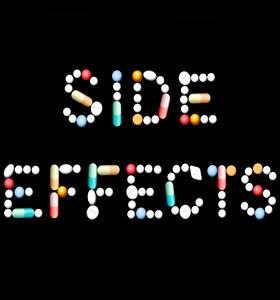The Ferocity of Chemotherapy: Does The End Justify The Means?
Medically reviewed on Nov 19, 2017 by L. Anderson, PharmD.
Empower Yourself: Learn About Cancer

Cancer. It’s one of the most dreaded words in the English language. You might shy away from learning about health conditions that scare you, like cancer. But knowledge of cancer and its treatments will empower you to help prevent its occurrence, understand your options and maybe even save your life. Here are 5 of the top cancers that occur in the U.S. You probably know a person who has been affected by at least one.
Cancer is Complicated, So You Need a Helping Hand

Cancer is a large group of diseases with many differences, but they all have one thing in common: abnormal cells growing out of control. As the cells multiply unchecked, they create a malignant tumor, what you might call cancer. Tumors aren’t always solid – they can be in the blood, too.
There are multiple types of cancer medications: either chemotherapy or immunotherapy. Some cancers, if caught early, are easy to treat, while others may require any combination of radiation, surgery, or drug treatment. Finding a knowledgeable and compassionate cancer (oncology) healthcare team is important. Rely on your family and friends for support, too.
Is Cancer Always Due to Genetics?

When something alters the cell DNA, cancer cells can begin to grow. A genetic predisposition for cancer is one of the most common risk factors for developing cancer. For example, if your mom had breast cancer, your chances of developing it may be higher. Other non-genetic cancer risk factors include:
- Estrogen exposure in women
- Too much ionizing radiation, like x-rays or nuclear
- Too much ultraviolet radiation, like UVB rays from the sun
- Cancer causing chemicals, like asbestos or benzene
- Tobacco smoke, heavy use of alcohol
What is Chemotherapy?

Chemotherapy (‘chemo’) is the use of anti-cancer drugs which kill rapidly-dividing cells in different ways – for example, by damaging DNA, halting cell division, or blocking cell metabolism. Chemotherapy can be given intravenously into a vein, by mouth, by injection into a muscle, applied to the skin, or in other ways. Many types of chemotherapy can be given at home or in an outpatient setting by a nurse.
Chemotherapy is usually given in cycles according to a protocol. One or several chemo drugs may be given over a period of time, (daily, weekly or monthly) with rest periods between treatment when no medicine is received.
Is Chemotherapy Always Needed to Treat Cancer?
There are many different options for cancer treatment, and your doctor will have the knowledge to direct you to your best choices. Many cancers are treatable and patients go on to live cancer-free for the rest of their lives. Your decision to have chemotherapy or other treatments should be based on sound knowledge of your cancer, the cancer stage at your diagnosis, the recommended therapy and side effects, and your prognosis – with or without chemotherapy.
For some people, treatment would always be their decision. For others, especially those with terminal cancer, hospice or palliative care may be their choice. Remember, chemotherapy is a choice, not a mandate.
Chemotherapy Has a Bad Rap. Are the Side Effects Controllable?

Chemotherapy works by destroying cancer cells, but many treatments affect the healthy cells, too. Side effects of chemotherapy are usually due to the drugs effect on the healthy cells.
You have probably heard about many of these side effects:
- hair loss
- nausea and vomiting
- increased risk of infections
- fatigue
- anemia
and the list goes on. Years of research have allowed health care professionals to know how to help you cope with the side effects of chemotherapy. There are treatments your doctor can use to reduce many of the side effects.
Does Everyone Lose Their Hair With Chemotherapy?

Hair loss is one of the most dreaded aspects of chemotherapy, even though other side effects may be more severe from a biological aspect. Hair loss can affect your self-confidence, lower your mood, and cause stress.
There is some good news – not all cancer drugs lead to hair loss. For those that do, it may range from thinning to complete baldness and will affect all areas of the body with hair. The other good news, hair loss due to chemo is not permanent. Hair usually begins to grow back 2 to 3 weeks after the last treatment. Many patients prefer to cut their hair short before treatment begins to lessen the psychological impact of hair loss.
How Can You Avoid Chemotherapy-Induced Nausea and Vomiting?

Chemotherapy-induced nausea and vomiting (CINV) can occur quickly, within the first 24 hours of chemotherapy, or it can be delayed (after 24 hours). You might also have anticipatory nausea/vomiting before your treatments. Chemotherapy results in the release of chemicals such as serotonin (5-HT3) in the intestine which can lead to the nausea/vomiting side effects.
The goal is to prevent chemo-induced nausea and vomiting, or to minimize it as best as possible. Today, there are very effective treatments for CINV. Drug treatments from the class known as 5-HT3 inhibitors are ground-breaking drugs for CINV.
What Treatments are Used for CINV?
The 5-HT3 inhibitors are by far the most common treatment used for patients to prevent CINV. Other agents, like dexamethasone and aprepitant (Emend), substance P/neurokinin-1 (NK 1) receptor antagonist may be added.
Common 5-HT3 inhibitors include:
- Palonosetron (Aloxi)
- Dolasetron (Anzemet)
- Granisetron (Kytril, Sancuso, Sustol)
- Ondansetron (Zofran)
The latest approvals are Akynzeo, a combination of palonosetron and a new drug called netupitant, which is an oral NK1 receptor antagonist. Sustol (granisetron), a long-acting, injectable 5-HT3 antagonist was cleared in August 2016. Both drugs can be used for acute and delayed chemo-induced nausea and vomiting.
In November 2017, the FDA approved Heron’s Cinvanti (aprepitant), a polysorbate 80-free, intravenous (IV) formulation of aprepitant, indicated for the prevention of CINV. It’s the first IV formulation to directly deliver aprepitant, the active ingredient found in Emend capsules. Approval was based on data demonstrating the bioequivalence of Cinvanti to Emend IV (fosaprepitant). Cinvanti reduces CINV in both the acute and delayed phases of treatment.
Safety of 5-HT3 Inhibitors

In general, the 5-HT3 inhibitors are well tolerated and have less side effects than older medicines given for nausea and vomiting, like promethazine (Phenergan). They can be given as an injection, by mouth as a pill, or as a patch for the skin.
The most common side effects might include dizziness, headaches, diarrhea or constipation, muscle cramps, and fatigue. You may have an increased risk for a very rare side effect called serotonin syndrome, so be sure to have a drug interaction review. Tell your doctor if you’ve had an allergic reaction to any other 5HT3 inhibitor drug.
Other Chemo Side Effects: An Increased Risk for Infections
Avoiding infections while you are receiving strong chemotherapy is important because infections can interrupt the cancer treatment cycle. Chemotherapy can cause neutropenia, an abnormally low level of a white blood cell called neutrophils, which increases a patient’s risk of infection. Neutropenia can be prevented through the use of white blood cell boosters such as pegfilgrastim (Neulasta), filgrastim(Neupogen), tbo-filgrastim (Granix), and sargramostim (Leukine). These drugs stimulate the stem cells in the bone marrow to produce more white blood cells that migrate to the blood to help fight infections. These drugs are classified as colony stimulating factors.
Combat Low Blood Oxygen From Chemotherapy
Anemia is a common problem encountered by cancer patients, either due to chemotherapy or the cancer itself. Anemia, defined as a low level of red blood cells, reduces the amount of oxygen that can be carried to the body. As a result, symptoms of anemia include tiredness, trouble breathing, lightheadedness, chest pain, chills, and pale skin. Correction of anemia is important to improve overall health and to allow chemotherapy to continue on schedule. Anemia can be treated with epoetin alfa(Procrit, Epogen) or darbepoetin alfa (Aranesp), usually in conjunction with supplemental iron. Blood transfusions may be an option, too.
What is the Future of Chemotherapy?

Cancer therapies are moving toward ‘targeted’ treatments – therapies that interfere with specific cancer-causing molecular targets that promote cancer growth. Immunotherapies are one example of next-generation cancer treatments. Targeted therapies are known as personalized medicines, as they work in conjunction with a person’s individual genetics to target cancer. In fact, many targeted therapies have already been FDA-approved.
Although researchers expect targeted therapies to be easier to tolerate than traditional chemotherapies, there are still significant side effects, like diarrhea, skin problems and liver toxicity. In contrast, traditional chemotherapy acts against all cells that are growing and dividing – normal and cancerous cells.
Which Cancers Do Targeted Therapies Treat?
There have been many FDA-approvals for targeted and immunotherapy therapies, most drugs treat many different types of cancer, and many may be used in combination. Targeted therapies are extending survival, too, as seen in melanoma. FDA-approvals include:
- Ipilimumab (Yervoy) – melanoma treatment, to lower risk of melanoma returning after surgery
- Imatinib (Gleevec) – leukemia (blood cancer), bone marrow disorders, skin cancer, and certain tumors of the stomach and digestive system
- Bevacizumab (Avastin) – brain, cervical, colorectal, kidney, rectum, cervix, ovary, or fallopian tube, abdomen lining, and lung cancers
- bevacizumab-awwb (Mvasi) – the biosimilar to Avastin, approved for metastatic colorectal cancer, non-small cell lung cancer, glioblastoma, metastatic renal cell carcinoma, and cervical cancer.
- Sorafenib (Nexavar) – kidney, liver, thyroid cancers
- Pembrolizumab (Keytruda) – non- small cell lung cancer (NSCLC), metastatic melanoma, head and neck squamous cell (skin) cancer, classical Hodgkin lymphoma, microsatellite instability-high cancer, and gastric cancer
- Nivolumab (Opdivo) – non-small cell lung cancer (NSCLC), melanoma, kidney cancer, Hodgkin’s lymphoma, head and neck cancer, urothelial (bladder) cancer, hepatocellular (liver) cancer
- Atezolizumab (Tecentriq) – bladder cancer, non-small cell lung cancer (NSCLC)
Finished: The Ferocity of Chemotherapy – Does The End Justify The Means?

Breast Cancer Therapy: Right On Target
Out With Gout – Everything You Need To Know About Gout
Sources
- FDA Approves Cinvanti (aprepitant) Injectable Emulsion for the Prevention of Acute and Delayed Chemotherapy-Induced Nausea and Vomiting (CINV). Drugs.com. Accessed November 19, 2017 at https://www.drugs.com/newdrugs/fda-approves-cinvanti-aprepitant-injectable-emulsion-prevention-acute-delayed-chemotherapy-induced-4630.html
- National Cancer Institute. Targeted Cancer Therapies. Fact Sheet. Accessed 3/18/2017 at http://www.cancer.gov/cancertopics/factsheet/Therapy/targeted
- The American Cancer Society. Infections in People with Cancer. Cancer.org. Accessed 3/18/2017 at https://www.cancer.org/treatment/treatments-and-side-effects/physical-side-effects/infections/infections-in-people-with-cancer.html.
- CancerConnect.com. Anemia overview. Accessed 3/18/2017 at http://news.cancerconnect.com/anemia/
- National Cancer Institute. Breast Cancer. Accessed 3/18/2017 at http://www.cancer.gov/cancertopics/types/breast
Against Cancer Fight
Leave a ReplyCancel reply
This site uses Akismet to reduce spam. Learn how your comment data is processed.
Eintraege – Postings
- The Chinese version of the German book is now available in China
- Das Glueck Zu Leben ( Buch)
- Weihnachtslesung IHK-AHK Shanghai 2013
- Das muss auch mal gesagt werden
- Bilder einer besonderen Frau 2 – More Pictures 2
- English translation: German “grandmother” is gone! But Eckhard said that he wants to carry charity on! Because this is the best nostalgia for her!
- 德国“洋奶奶”走了!但爱卡德却说要将慈善进行到底!因为,这是对她最好的怀念!
- Zhejiang TV Video Charity
No Comments